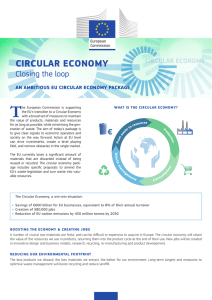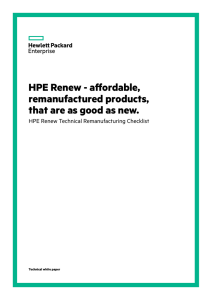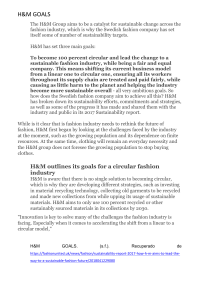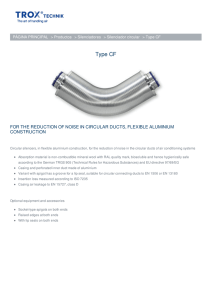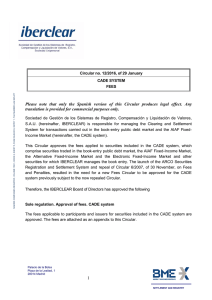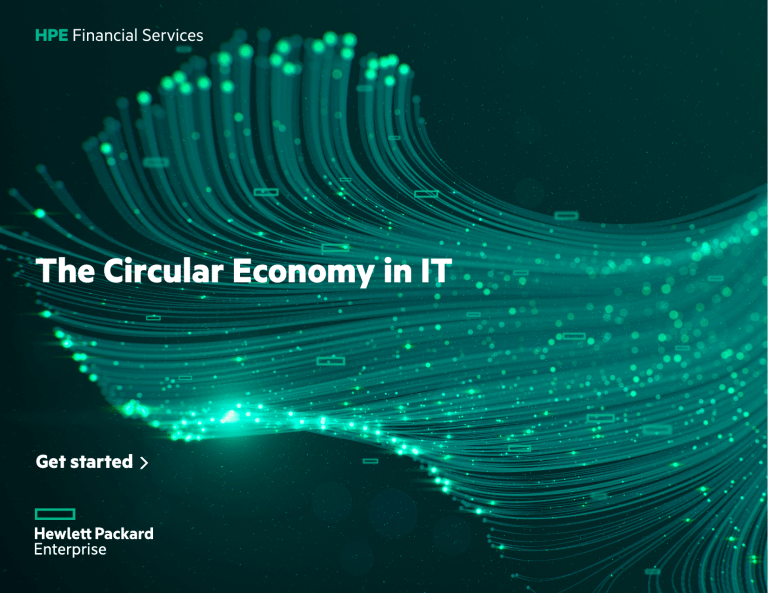
HPE Financial Services The Circular Economy in IT Get started HPE Financial Services What you’ll find in this eBook … Table of contents Chapter 1: The Circular Economy in IT and incentives to act Chapter 2: The Circular Economy and IT Mindsets Study Chapter 3: Take action—Our challenge to you Tip: This is an interactive eBook, click around to make the most of it! The Circular Economy in IT 2 HPE Financial Services What is the Circular Economy? The Circular Economy decouples economic growth and development from the consumption of finite resources. It aims to keep products, components and materials at their highest utility and value at all times, and eliminate waste across a product’s lifecycle through superior design and re-use. Design out waste and pollution Keep products and materials in use Regenerate natural systems Webster, Ken, The Circular Economy: A wealth of Flows – 2nd Edition, January 31, 2017, Ellen MacArthur Foundation The Circular Economy in IT 3 HPE Financial Services The rise of e-waste and urgency for change Digital advancement in conjunction with rising disposable incomes and industrialization in developing countries has caused an explosion of e-waste*. It has become one of the world’s fastest-growing waste streams, and is taking a toll on our planet. And the problem is only growing. Emerging technologies 3.6B 1 People online In 2017, close to half the world’s population used the internet and most people in the world had access to mobile networks and services. 2 like AI and blockchain will require an enormous amounts of compute power and technology to reach their imagined scale — outpacing our energy, space, and material resources. This rapid pace of innovation in IT is increasing the need for a Circular Economy. *E-waste: Includes a wide range of products, almost any household or business item with circuitry or electrical components with power or battery supply *ICT: Information and communication technology Baldé, C.P., Forti V., Gray, V., Kuehr, R., Stegmann,P. : The Global E-waste Monitor – 2017, United Nations University (UNU), International Telecommunication Union (ITU) & International Solid Waste Association (ISWA), Bonn/Geneva/Vienna. 1234 “[52.2 million metric tonnes=452,000 blue whales]”. The Measure of Things. Bluebulb Projects’ The Measure of Things. Web. [Date Visited: 11/08/2018] https://www.bluebulbprojects.com. 5 More devices shorter cycles Many people own more than one ICT* device, and replacement cycles for mobile phones and computers, and also for other devices and equipment, are becoming shorter. 3 52.2M View to get the facts Metric tonnes The amount of e-waste is expected to increase to 52.2 million metric tonnes by 20214 —equivalent to 452,000 blue wales! 5 The Circular Economy in IT 4 HPE Financial Services E-waste is generating a surprising economic prospect E-waste is rich in valuable minerals like gold, silver and 20% copper. Yet, most e-waste is not properly documented Only 20% of e-waste generated is documented to be collected and recycled.2 or treated through the appropriate recycling channels. And many products end up in a landfill that could have refurbished and kept in use for longer. This type of inefficiency goes against key Circular Economy principles since valuable and scarce resources are wasted. €55B The total value of all raw materials present in e-waste was estimated to be ~55 Billion Euros in 2016.3 Organizations from all industries are finding new ways to sustainably meet the needs of our future while serving their own economic interest. The Ellen MacArthur foundation reports: “Economic actors in the circular economy have started to tackle waste issues through new private sector business models supporting the circular economy such as ‘reuse, View to get the facts repair, and remanufacture instead of ‘replace,’ and ‘selling goods as a services.’” 1 Webster, Ken, The Circular Economy: A wealth of Flows – 2nd Edition, January 31, 2017, Ellen MacArthur Foundation 1 Baldé, C.P., Forti V., Gray, V., Kuehr, R., Stegmann,P. : The Global E-waste Monitor – 2017, United Nations University (UNU), International Telecommunication Union (ITU) & International Solid Waste Association (ISWA), Bonn/Geneva/Vienna. 23 The Circular Economy in IT 5 HPE Financial Services Incentives To Act Incentives To Act When it comes to the incentives to participate in the Circular Economy, Morals & Ethics the benefits go beyond just the “right thing to do” for the environment. Gartner reports: “There are many reasons why companies pursue these so called “circular economy” strategies. Among them are an altruistic desire to do what’s best for the environment and society, combined with a commercial desire for continued differentiation in competitive markets.”1 Click the buttons on the image to learn more about the incentives to act! Economic Opportunity 1 Compliance & Regulations .Gartner, The Gartner Supply Chain Top 25 for 2018, May 18 2018, ID: G00351344 The Circular Economy in IT 6 HPE Financial Services Incentives To Act Morals & Ethics Best practices in IT sustainability are becoming more and more Morals & Ethics important to customers, investors and employees. People care about the environment and want to purchase from, work for and invest in businesses who do, too. “Institutional investors and consumers claim that they will put their money on companies that do right by people and the planet. Companies that opt to “wait and see” if these stakeholders actually shift their values and spending patterns over the next five years will find it impossible to catch up if sustainable business becomes the new standard.” 1 Economic Opportunity Compliance & Regulations .Gartner, How to Lead Supply Chain in the Big Shift to Sustainable Business: A Gartner Theme Insight Report, March 21 2018, ID: G00350699 1 The Circular Economy in IT 7 HPE Financial Services Incentives To Act Economic Opportunity In the age of digital disruption, you face a constant need to upgrade Morals & Ethics your technology to support new business models and customer experiences. But, you can still keep up with the pace of change while participating in the Circular Economy —and gain an economic advantage in the process. When upgrading IT, many organizations upcycle, remarket and resell their unneeded equipment to return money back to their IT budget — a strategy that can pool money into innovation, and help extend the life of functional assets. In terms of expanding environments, adapting pre-owned equipment instead of buying new has financial payback. In fact, the savings from choosing functionally equivalent used hardware over new can be dramatic. And when purchasing brand new IT, consider technology that is designed for energy efficiency, and easy recycling and removal Economic Opportunity Compliance & Regulations of heavy metals for reuse. The Circular Economy in IT 8 HPE Financial Services Incentives To Act Compliance & Regulations Official policies and legislation on the proper disposal of technology Morals & Ethics has become increasingly adopted around the world. In January 2017, ~4.8 billion people were covered by national legislation, which is 66% of the world population, up from just 44% in 2014. 1 E-waste policies are progressively moving beyond just recycling, promoting Circular Economy models that not only encourage collection and recycling, but also value reusing, refurbishing, and remanufacturing at end of useful life. 2 Not being compliant can be devastating for a company’s bottom line and brand reputation. Improper disposal settlements have reached into the millions of dollars. And hefty fines aren’t the only risk— sensitive data like customer or employee information left on discarded technology. Baldé, C.P., Forti V., Gray, V., Kuehr, R., Stegmann,P. : The Global E-waste Monitor – 2017, United Nations University (UNU), International Telecommunication Union (ITU) & International Solid Waste Association (ISWA), Bonn/Geneva/Vienna. 12 Economic Opportunity Compliance & Regulations The Circular Economy in IT 9 HPE Financial Services The Circular Economy and IT Mindsets Study To better understand the state of the Circular Economy in IT, HPE Financial Services conducted a study with IT leaders from around the world. 500 IT Leaders The purpose of the study was to: ——Determine presence of environmental sustainability strategies in IT From US, UK, Spain and France ——Measure awareness and understanding of the Circular Economy, and desire to be a part of it Enterprise & SMB-sized companies View Participant Data Cross Industry The Circular Economy in IT 10 HPE Financial Services Key takeaways from the study 1 Most organizations have an environmental sustainability strategy, and the Circular Economy on their radar—and not only because it’s the “right thing to do” for the environment 2 IT functions are participating in environmental sustainability at the most basic level— and lagging behind in adoption compared to the overall organization 3 Nearly half of companies are heavily regulated and required to report on environmental impact, and IT organizations have an opportunity to maximize contributions while adding economic value HPE Financial Services, The Circular Economy and IT Mindsets Study, September 2018 The Circular Economy in IT 11 HPE Financial Services 1 2 3 Most organizations have an environmental sustainability strategy, and the Circular Economy on their radar — and not only because it’s the “right thing to do” for the environment Most companies (79%) have an environmental sustainability strategy with formal goals and KPIs in place. These strategies are set from the top down—with over half of organizations driving towards KPIs and goals set by C-suite leadership. Moreover, the Circular Economy is on the agenda of most organizations. In fact, 64% said they are already familiar with and discussing the Circular Economy. And of those organizations, nearly all (90%) believe being part of the Circular Economy is important. Respondents note benefits that go beyond just the “right thing to do” for the environment, and recognize the intrinsic value in Circular Economy participation. For example, having a positive influence on corporate reputation, and making employees proud to work for their company. However, there is still much more work to be done in this space. Although most companies have environmental sustainability goals, there are still 21% of companies that do not. And these organizations will have difficulty catching up if sustainable business becomes the new normal. Furthermore, the goals cited were concentrated on efforts like the reduction of power consumption and carbon footprint, and increasing recycling — and there was a lack of goals aligned to Circular Economy core principles like re-use and keeping products in use for longer. Get to the facts HPE Financial Services, The Circular Economy and IT Mindsets Study, September 2018 The Circular Economy in IT 12 HPE Financial Services 1 2 3 IT functions are participating in environmental sustainability at the most basic level— and lagging behind in adoption compared to the overall organization Only 69% of IT organizations have environmental sustainability goals and KPIs specific to technology. And since 79% of organizations have a company-wide sustainability strategy, it means IT functions are trailing behind compared to the organization as a whole. Similar to the wider organization, IT organizations are narrowly focused on goals like the reduction of power consumption. This laser focus on just one aspect of environmental sustainability is most likely a residual effect of the first energy crisis in 1973, which made global news headlines and resulted in an influx of energy-related policy. Energy efficiency is a notable goal, but objectives aligned to Circular Economy principles like reusing end-of-life products, remarketing idle resources and extending the life IT equipment should be integrated into IT sustainability plans as well. Get to the facts HPE Financial Services, The Circular Economy and IT Mindsets Study, September 2018 The Circular Economy in IT 13 HPE Financial Services 1 2 3 Nearly half of companies are heavily regulated and required to report on environmental impact, and IT organizations have an opportunity to maximize contributions while adding economic value Environmental legislation is becoming more commonplace and strict around the world. And so it makes sense that nearly half (48%) of the companies we talked to are heavily regulated and required to report carbon and environmental disclosures. However, most IT organizations are not working on goals that support a Circular Economy. For this reason, they are missing an opportunity to help meet their organization’s environmental requirements and maximize their contributions towards a more sustainable world. In addition, business value is being overlooked. With innovation pressures rising, IT budgets barely expanding, and shorter and shorter technology lifecycles— IT organizations should take measures to add value back to their business through the Circular Economy. For example, upcycling and remarketing idle equipment can give functional assets a second useful life, and in turn provide money back to the business. Furthermore, choosing pre-owned equipment where appropriate can help expand budget for innovation projects where new technology is absolutely required. These are just a few examples of how IT organizations can take action in line with the Circular Economy to gain both environmental and economic benefits. Take action HPE Financial Services, The Circular Economy and IT Mindsets Study, September 2018 The Circular Economy in IT 14 HPE Financial Services Take action—Our challenge to you Form a partnership with your Sustainability team – be a part of your company’s sustainability program Ensure at least 75% of your retired assets go back “into the circle” Measure your contribution to the Circular Economy and hold yourself accountable 9 out of 10 IT leaders who know about the Circular Economy think it is important. Now, let’s take action! HPE Financial Services, The Circular Economy and IT Mindsets Study, September 2018 The Circular Economy in IT 15 HPE Financial Services The Circular Economy in IT Our mission at HPE is to advance the way people live and work. We’re making a real contribution to the Circular Economy in IT by providing best-in-class products, services, and reporting capabilities that help customers like you meet business and environmental sustainability goals. Let’s do this together. Learn more at hpe.com/info/circulareconomy Join the #HPEUpcycling conversation on Linkedin or Twitter Design and Manufacturing Material Sourcing Distribution Recycling HPE Asset Upcycling Services and Certified Pre-owned Product Use Financing and service offerings available through Hewlett-Packard Financial Services Company and its subsidiaries and affiliates (collectively, “HPFSC”) in certain countries and is subject to credit approval and execution of standard HPFSC documentation. Rates and terms are based on customer’s credit rating, offering types, services and/or equipment type and options. Not all customers may qualify. Not all services or offers are available in all countries. Other restrictions may apply. HPFSC reserves the right to change or cancel this program at any time without notice. The CER is provided to illustrate the estimated environmental impacts that result when assets are returned to HPFSC after use. HPFSC believes this information is substantially representative of the resources reclaimed or saved through our processing methods. The values contained in the CER are estimates that reflect potential - not actual – recycling and reuse rates. The various statistics and values depicted in the CER are based on asset return volumes for IT products within general product categories subsequent to return to HPFSC. Statistical conversion coefficients and other methods of estimation are applied to evaluate the types of materials that specific products, or products of substantially similar description, typically contain. The information depicted in the CER is provided for discussion and information purposes only. HPFSC makes no representations or warranties, and shall have no liability to any party for any damages, claims or losses of any kind whatsoever, whether direct, incidental, indirect, special or consequential, arising out of or in connection with the CER, the information contained therein or the procedures used to create the CER. In providing the CER, HPFSC is not providing any service to the CER’s recipient and is under no obligation to provide any additional reports to such recipient. a00060221enw, November 2018 The Circular Economy in IT 16
